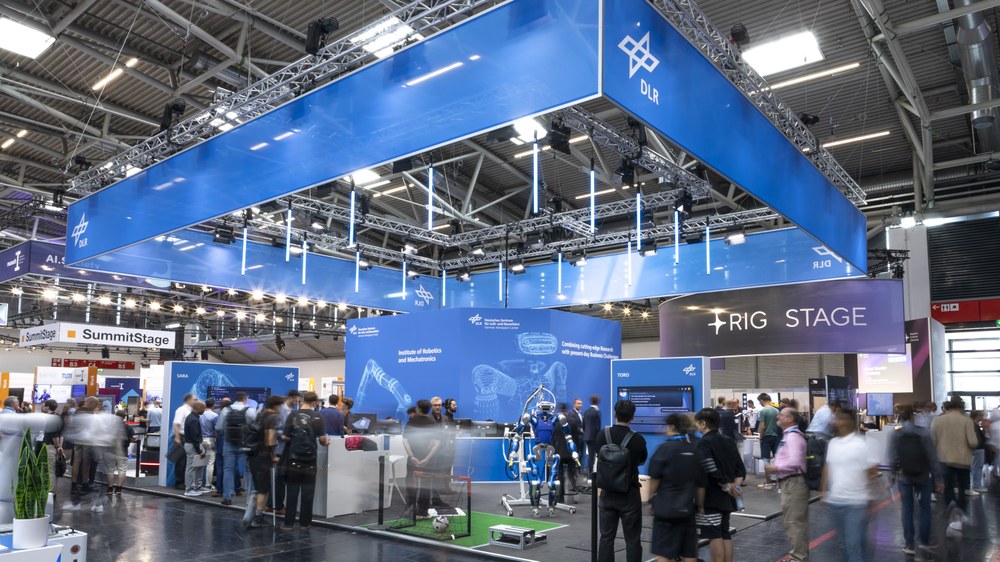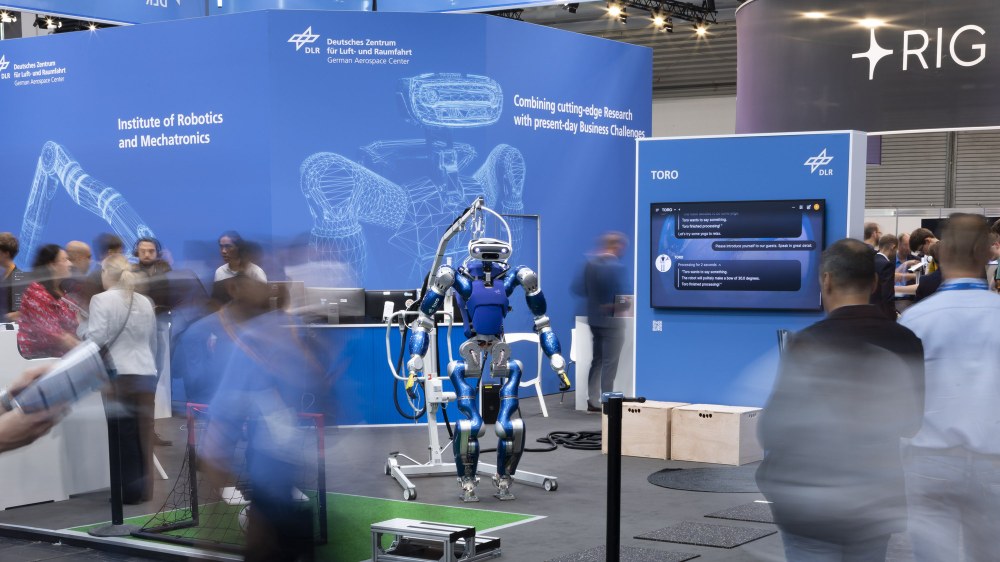DLR showcases robotics highlights at automatica 2025



- At automatica 2025, DLR will present innovative robotics solutions from the fields of assistance, medical and production robotics.
- The DLR stand (Hall B4, Stand 321/324) will focus on technologies that enable robots to perceive their environment, act flexibly and interact safely with humans.
- Cooperation with industry and research is sought after to bring developments quickly and practically into application.
- Focus: Robotics, space, digitalisation, Industry 4.0
From 24 to 27 June 24 2025, the German Aerospace Center (Deutsches Zentrum für Luft- und Raumfahrt; DLR) will showcase highlights of its work on robotics at automatica 2025 in Munich, Germany – the leading trade fair for intelligent automation and robotics. The focus will be on the future of production, assistive robotics, medical robotics and technologies that enable robots to perceive and interact with their environment. At the DLR booth (Hall B4, Stand 321/324), the Institute of Robotics and Mechatronics will also host euROBIN, Europe's 'Network of Excellence' that brings together European expertise on robotics and artificial intelligence (AI). With a networking event for female experts, DLR, in cooperation with the international 'Women in AI & Robotics' network, is also specifically addressing this specialist audience.
"Robotics is a key technology for Germany as a centre of technology and business. In 2004, DLR brought automatica to Munich and it has since become the world's leading robotics trade fair. This year, we are showcasing innovations from aerospace research that are being further developed for practical use on Earth – a particular highlight is the combination of humanoid robots and artificial intelligence. To quickly bring our research into practical use, we put a strong emphasis on collaboration with industry and other research institutions," explains Alin Albu-Schäffer, Director of the DLR Institute of Robotics and Mechatronics.
Humanoid robot with intelligent perception
Since 2013, TORO (the TOrque-controlled humanoid RObot) has evolved from a bipedal walking robot into a versatile humanoid robot standing 1.74 metres tall. Its joints are compliantly controlled, enabling it to safely interact with humans, walk robustly and climb stairs. Now, TORO can also see, feel and 'understand' its surroundings. A novel process developed at the institute enables TORO to intelligently interpret visual data from its camera 'eyes' and respond accordingly.
The robot has the ability to recognise its surroundings and assess the situation around it – giving it the ability to perform tasks autonomously in the future. This is particularly important for robots intended to help in households or in caregiving roles. At automatica, TORO will demonstrate how it combines its dynamic capabilities with new AI features through compliant movements, balancing in yoga poses and playing football. Situation awareness is enabled by machine vision and a large language model (LLM), allowing TORO to better perceive and respond to its environment in a targeted manner and to adjust its movements with greater precision.
Upcoming spin-off with assistive robotics prototype
At automatica 2025, the 'Re-enabling Robotics' team is unveiling their newly developed robotic arm. This new assistance robot is specifically designed for wheelchair users and is the prototype for the first product from the development team, which is currently in the process of spinning off. The semi-autonomously controlled robotic arm is intended to make everyday life easier for people with severe physical disabilities. It can help with tasks such as grabbing a bottle, pouring a drink or opening doors. The kinematics have been specially tailored for wheelchair use, so the robot arm integrates seamlessly, is intuitive to operate and retains its precision and performance. Certified joints from the DLR spin-off SensoDrive ensure its safe operation.
MIRO – ultrasound diagnostics and tissue examination
In the field of medical and surgical robotics, the MIRO Innovation Lab – DLR's competence centre for medical robotics – is presenting its latest research in robot-assisted ultrasound diagnostics. DLR's MIRO robot system, based on a remotely controlled robotic arm, fuses ultrasound with other imaging techniques – and the combination and integration of these various sensors is unique. Another highlight is the automatic examination of tissue; the MIRO robotic arm guides sensors to precisely the area of interest, allowing high-quality tissue data to be obtained.
Factory of the future
In the factory of the future, humans and autonomous robot systems will work together closely and adapt quickly to new tasks. To support this collaboration, DLR is developing technologies to enable economical, sustainable and efficient production at any volume. The Institute of Robotics and Mechatronics is presenting its SARA, AIMM and Digital Twin projects.
SARA – flexible workstation
DLR's lightweight robot SARA (the Safe Autonomous Robotic Assistant) forms the central component of a workstation that can be easily reconfigured. This allows the system to be quickly adapted to new products and individual orders. In an interactive grinding application from the LEROSH project, the DLR team demonstrates how SARA can perform grinding tasks quickly and precisely using 3D point clouds and an intuitive interface. Another application example involves measuring bearing rings. SARA is programmed through natural interaction with humans and language models.
AIMM – robotic handling and transport
DLR's AIMM (Autonomous Industrial Mobile Manipulator) robot system specialises in handling and transporting items in partially unstructured environments. AIMM consists of a robot arm integrated on a mobile platform and is suitable for manufacturing and automation tasks, such as in laboratories. AIMM is not only capable of performing complex manipulation tasks, but also of completing tasks completely independently. To achieve this, the robot combines intelligent methods for perception, data processing and path planning. At the DLR exhibition stand, visitors can see how AIMM flexibly and autonomously completes complex tasks in laboratories with robotic systems.
Digital twin
The digital twin concept brings together all product-relevant information. The Institute of Robotics and Mechatronics is presenting a multi-physical digital twin that particularly incorporates dynamic behaviour models. These include, for example, mechanical motion sequences, contact forces and energy flows. With the help of specially developed 'Modelica libraries' – including those for assembly, robot dynamics and thermodynamics – the digital twin can be used to simulate and optimise complex processes to commission robotic systems and production facilities faster and more efficiently, while also reducing operating costs. The DLR development team will present use cases from various fields, including MoRC – its new modular industrial robot control unit.
Intelligent gripping
One skill that robots need in both industrial and household environments is the ability to grasp and handle objects safely. A circuit board, a coffee cup or a mango need to be grasped in different ways and with different levels of force. The DLR Institute of Robotics and Mechatronics is presenting its IntelliMan and SoftEnable projects.
IntelliMan applies the 'Learning from Demonstration' (LfD) method to develop robust, reactive grasping strategies. By combining specialised rule sets with machine learning and model-based computer vision techniques, the robot can dynamically adapt its behaviour to changing environments and reliably grasp a variety of objects. This technology is applicable in many areas – from picking up objects from a conveyor belt to human-robot interactions.
SoftEnable introduces a novel approach for handling delicate, deformable items like food. The demonstrator features an innovative fingertip gripper that slides under objects, a compliant palm to stabilise the objects and integrated sensors to ensure precise and reliable control. At the DLR stand, the robot system demonstrates how this works by grasping and putting down soft fish dummies. In the future, the technology could be used in food processing automation, medical handling and other sensitive applications.
